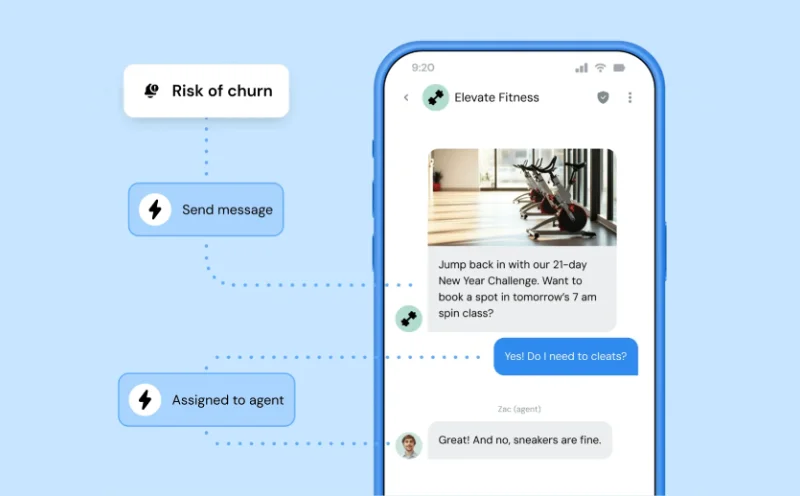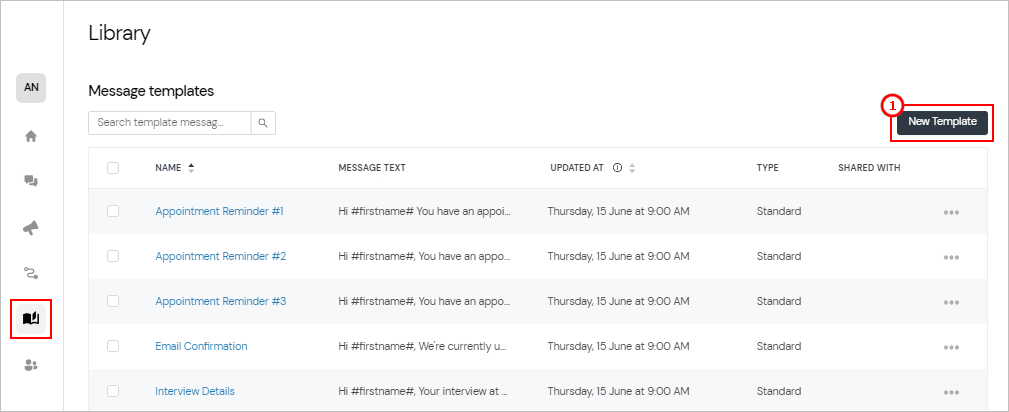Resources
Sales text messaging: How to turn SMS conversations into conversions

Resources

In a time when inboxes are flooded and ad fatigue is real, sales teams are increasingly turning to the most direct, intimate channel at their disposal: SMS. With almost-instant attention and consistently high engagement, an engaging text conversation can move prospects along your pipeline faster than many email or call strategies.
In this post, you’ll discover why SMS is such a powerful tool for driving sales, see the latest statistics that prove its ROI, and learn a simple five-step framework to turn your texts into conversions. You’ll also get actionable best practices, ready-to-use templates, and tips on common mistakes to avoid – so let’s dive in.
The average SMS campaign has an open rate of around 98%.
Click-through rates (CTR) for SMS campaigns average 19–20%, while email often delivers much lower CTRs.
~75% of consumers say that text messages from brands routinely drive them to make purchases.
These numbers show that SMS isn’t just a novelty – it’s a conversion engine when used strategically.
Here’s a structured approach your sales team can deploy:
| Stage | Purpose | Key message Focus | Example |
| 1. Opt-in capture | Get permission to text | Clear value, explicit consent | “Text JOIN123 to 555-123 to receive VIP offers and updates. Msg & data rates may apply. Reply STOP to opt-out.” |
| 2. Introduction/ rapport | Establish context & trust | Identity + purpose | “Hi [Name], this is [Your Name] from [Company]. We chatted earlier about [Pain Point]. Do you have 2 mins for a quick idea I can text over?” |
| 3. Need Discovery/ qualification | Surface pain, budget, timeline | Ask one or two short questions | “What’s your #1 priority this quarter for [topic]? (A) reduce cost, (B) increase revenue, (C) other” |
| 4. Offer/ value proposition | Show your solution’s benefit | Tie it to their pain + call to action | “If I could show you a way to reduce X by 15% in 90 days, would that be interesting? I can send a short ROI snapshot.” |
| 5. Follow-up/ close push | Reinforce urgency | Reminder, deadline, next step | “Circling back – our promo ends Friday. I’d hate for you to miss it. Want me to reserve your spot?” |
This step-by-step guide helps you think of SMS as a way to actively drive the conversation forward, not just a way to blast off information.
Here’s a helpful list of things your sales team should consistently apply when texting leads and customers.
Without it, you risk legal trouble (TCPA, CTIA, etc.).
Use double opt-in if possible: after they sign up, have them reply “YES” to confirm.
Begin your message with your name or company name so the recipient isn’t wondering who’s texting.
You’re limited to ~160 characters. Prioritize clarity over cleverness.
Don’t waste a chance to drive a desired action, and be careful not to make things complicated with multiple asks. Ideally, end with a single, direct next step (e.g. “Reply YES,” “Click link,” “Call me”).
Insert name, company, or specific context so that it’s more likely to resonate and drive responses.
Phrases like “limited time,” “expires Friday,” or “only 3 slots left” can help, but don’t overdo it.
Avoid sending very early or very late. Mid-to-late afternoons are often sweet spots. Also, if you have a large audience that spans regions, segment by time zone so you don’t wake someone at 3 am.
Too many messages lead to fatigue and unsubscribes. 2–4 per month is a common recommendation when it comes to promotional texts, while one-on-one texts (or two-way SMS) can be a bit more regular based on the conversation flow.
Don’t let leads go cold if they send a text reply but a sales rep isn’t available. Use automated fallback for unattended replies that acknowledge messages after hours or when response times are high.
For example:
“Thanks for your message! You’ve reached [Company Name]. A team member will reply first thing in the morning.”
Sales teams are no strangers to measuring outcomes, so SMS campaigns are no different. A/B test message variants, send times, CTA phrasing, etc. Track deliverability, open rate, reply rate, click rate, conversion.
Sinch Engage makes this part easy with built-in SMS analytics.

Use natural language and a friendly tone. SMS feels like personal space for many customers, so make your messages sound like they came from a real human.
Here are a few ready-to-go templates. Feel free to adapt tone and details to your brand and audience.
Use case: After a lead fills a form
Text message template:
“Hi [Name], this is [Your Name] from [Company]. Thanks for your interest in [Offer]. Would you prefer I text over a few options or schedule a call?”
Use case: For qualification or discovery
Text message template:
“Quick Q: what’s your priority this quarter:
(A) cut costs, (B) grow revenue, (C) improve ops?”
Use case: Sharing a case study
Text message template:
“Hey [Name], we helped [Similar Company] boost sales by 23% in 90 days. Want me to send you a 1-page summary?”
Use case: Giving a special sales offer
Text message template:
“We’re offering a 20 % discount for new clients who commit by Fri. Want me to reserve a slot for you?”
Use case: General follow up
Text message template:
“Hey [Name], did you get a chance to look at the ideas I sent? Happy to jump on a quick call if useful.”
When you send from a template, take the time tailor one or two lines (or encourage your reps to take the time) – so it doesn’t feel copy-paste.
With a texting platform like Sinch Engage, you can even create and save these templates for easy reuse, making things even more efficient and actionable for every sales rep.

To execute at scale (without losing the conversational feel), pair SMS with your existing tools:
Use a platform that supports SMS (or integrates via API) so texts are synced with contact records, notes, and sequences.
Sinch Engage is a leading, secure SMS platform that also integrates with top sales CRMs and software like Salesforce, HubSpot, and Zoho CRM.
Trigger texts based on prospect actions, like form submitted, link clicked, proposal sent, etc.
Monitor metrics like delivery rate, open rate (if available), reply rate, conversion rate, opt-out rate. Analyze performance by persona, message variant, time of day.
Use SMS to complement, not replace, email or LinkedIn. For example, send an email and follow with a text saying, “I just sent you something. Want to take a look and lmk what you think?”
This layered approach tends to outperform single-channel pushes.
Text messaging isn’t just a faster way to reach people – it’s a smarter way to drive sales. Your prospects are constantly looking at their phones already, and if you’re able to bring a clear message at the perfect time (with a relevant and genuine intent to help), your outreach can cut through to them while other methods don’t.
If you’re ready to see what that looks like in practice, try Sinch Engage for free or book a demo and start seeing how SMS can help you drive your sales numbers up and to the right for next quarter and beyond.